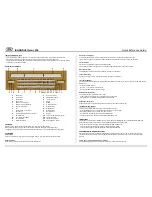
Version 1.0 – January, 2015
CAPTURE MEMORY
Through use of the capture memory, a registration can be made active with just one piston. The capture memory
consists of 75 levels. These levels can be seen on the display (Mem:..). Each level has eight memory locations
(pistons 1-8). The 600 capture memory locations are not pre-programmed and can be programmed by the
musician.
Programming a capture memory location:
Warning: the current setting of the capture memory location will be lost.
- Select the desired stops.
- Use the - and + pistons to select a level (1-75) on the display.
- Press the SET piston and hold the piston.
- Press the desired memory location (1-8).
- Release the SET piston.
Calling up a capture memory location:
- Use the - and + pistons to select the desired level (1-75) on the display.
- Press the desired memory location (1-8). The active stops light up.
CHANGING REVERB
Although it is possible to select a different reverb for each intonation style and -variation it is advisable to select
the same reverb for all variations of one intonation style.
ASR-12
TM
:
-
Use the ROM, SYM, BAR, HIS, SOLO and TRIO pistons to activate the intonation style and -variation of which the
reverberation must be changed.
-
Press the MENU piston and use the - and + pistons to select the ‘Reverb Settings’ function on the display.
-
Press the ENTER piston and use the - and + pistons to select the Reverb function which has to be changed.
-
Press the ENTER piston to confirm.
-
The line at the top indicates the active intonation style.
-
The line at the bottom indicates the setting of the selected reverb function.
-
Use the - and + pistons to change the setting and press the ENTER piston to confirm.
-
Press the MENU piston twice to exit the Johannus Menu.
LIVEreverb
TM
(optional)
:
-
Use the ROM, SYM, BAR, HIS, SOLO and TRIO pistons to activate the intonation style and –variation of which the
reverberation must be changed.
-
Press the MENU piston and use the – and + pistons to select the ‘Reverb Settings’ on the display.
-
Press the ENTER piston and use the – and + pistons to select the desired reverb and press the ENTER piston to
confirm.
-
Press the MENU piston twice to exit the Johannus Menu.
Adaptive Ambiance System
TM
:
only with LIVEreverb
TM
Adaptive Ambiance System
TM
is a function which works with LIVEreverb
TM
to position the organ sound in the
church. There are four locations: at the console of the organ, in the front, in the center or in the rear of the church.
-
Press the MENU piston and use the – and + pistons to select the ‘Ambiance’ function on the display.
-
Press the ENTER piston and use the – and + pistons to select the desired location.
-
Press the ENTER piston to confirm and press the MENU piston to exit the menu.
The volume control
CATHEDRAL is besides adjusting the volume of the reverb also used to adjust the balance
between the organ sound and the ambiance.
VOLUME CONTROLS
Organ
: The volume of the organ can be adjusted with the ORGAN volume control.
Cathedral:
The reverb volume can be adjusted with the CATHEDRAL volume control.
Expression pedals:
In the standard version the organ has two expression pedals. One is configured as a swell pedal
for the Swell, the other is configured as a crescendo pedal. With use of the Johannus Menu, function ‘Expression
Pedals’, the function of the expression pedals can be changed.
Using an expression pedal which is set as a swell pedal will, next to the volume, also change the timbre of the
stops. This simulates the effect of the swell box shutters of a pipe organ.
Crescendo pedal:
The crescendo pedal can be used to activate 20 registrations step-by-step. These registrations
start with very quiet (pianissimo) to very loud (tutti). If the crescendo pedal is not activated it is indicated on the
displays with ‘Cr:--’. Use the CR piston to activate the crescendo pedal. The display indicates the current step.
Using the Johannus Menu, function 'Expression Pedals', the crescendo pedal can also be configured as a swell
pedal. If the crescendo pedal is set as a swell pedal, all functions of the original crescendo pedal are deactivated.
EXTERNAL CONNECTIONS
The external connections are on the left underneath the console.
MIDI IN:
An input for receiving MIDI codes from other devices.
MIDI MOD:
A programmable MIDI output for connecting a module or expander, for example.
MIDI SEQ:
A non-programmable MIDI output for connecting a Johannus MIDI Se or PC (with the optional
Johannus INTONATprogram), for example.
AUX IN:
A stereo audio input for playing the sound of an external device through the amplifiers of the organ. For
example, an expander connected to the organ through the MIDI MOD. can be played through the instrument's
loudspeakers.
AUX OUT:
A stereo audio output for connecting an external device (e.g. amplifier or recording device).
PHONES:
The phones connection is located on the left next to the manuals. This connection is suited for a
headphone with an impedance of 30 Ω or more (see headphone specifications).
For further information see CD User Manual.
© 2015 Johannus Orgelbouw B.V.


